Dubbing videos into Brazilian Portuguese has become an essential strategy for content creators aiming to connect with Portuguese-speaking audiences across Brazil and beyond. With Portuguese being the sixth most spoken language globally, primarily through the influence of Brazil's massive market, it offers a powerful avenue for effective localization. Whether you’re adapting marketing materials for Brazilian audiences, translating a podcast like Mamilos or Café da Manhã, or localizing popular shows for platforms like Globo or SBT, dubbing can dramatically expand your reach within Brazilian Portuguese-speaking markets. In this blog, we’ll dive into the details of Brazilian Portuguese video dubbing, comparing traditional dubbing techniques with AI-powered solutions, and showcasing how Speechify Studio’s AI voice generator streamlines the process.
What is Brazilian Portuguese Dubbing?
Brazilian Portuguese dubbing is the process of replacing the original language of a video’s audio track with voice overs in Brazilian Portuguese. While it may seem like it’s simply translating English or other languages into Portuguese, there's much more to it. Dubbing into Brazilian Portuguese must account for cultural nuances, regional slang, and variations in tone and formality, which are specific to Brazil and distinct from European Portuguese.
For example, the casual "you" in Brazilian Portuguese is "você," while in Portugal, "tu" is often used. This difference in speech can change how natural and relatable the dubbed content feels to the audience. The inclusion of Brazilian idioms like “dar um jeitinho” (finding a workaround) and colloquial phrases ensures the audience feels the content is speaking directly to them. Dubbing for the Brazilian market isn't just about linguistic accuracy—it's about creating an authentic cultural experience.
Brazilian Portuguese Dubbing Options: Traditional vs. AI Video Dubbing
When it comes to dubbing Brazilian Portuguese videos, content creators can choose between traditional dubbing with human voice actors or AI-powered dubbing, which utilizes advanced text to speech and voice cloning technology. Both methods offer unique advantages, so let’s take a look:
Traditional Brazilian Portuguese Dubbing
Traditional dubbing in Brazil involves hiring professional voice actors to record the script in a sound studio. These actors bring to life not just the words but the emotions, rhythm, and natural intonations of Brazilian Portuguese. In Brazil, traditional dubbing is an established industry, with classic examples in Brazilian television like “Chaves” (a Mexican show dubbed into Portuguese) or Hollywood blockbusters.
However, traditional dubbing can be expensive and slow, especially for small content creators or businesses that frequently produce multilingual content. In Brazil, the cost of voice talent, studio time, and post-production editing can make traditional dubbing prohibitive for certain sectors like educational YouTube channels or independent film projects.
AI-Powered Brazilian Portuguese Dubbing
AI-powered Portuguese dubbing, particularly for Brazilian audiences, has opened up new opportunities for more flexible, cost-effective dubbing solutions. AI-powered platforms like Speechify Studio allow creators to generate voice overs using artificial intelligence that mimics human speech, complete with Brazilian Portuguese pronunciation and intonation.
AI technology has advanced to the point where it's not only affordable but incredibly lifelike. For example, when creating video content for Brazil, an AI voice generator can be programmed to replicate regional accents, such as a Carioca accent (from Rio de Janeiro), where the “s” sound at the end of a word might be pronounced with a “sh” sound, adding authenticity to the voice over. AI-powered solutions like this allow for faster production times, real-time editing, and the ability to customize tones—whether formal or informal—to suit different types of content and target audiences.
How to Dub a Portuguese Video Using AI Voices with Speechify Studio
Speechify Studio streamlines the process of dubbing videos into Brazilian Portuguese with AI voices. Here’s how to get started:
Create a new project: Begin by clicking on “New Project” and choosing “Dubbing” as your project type.
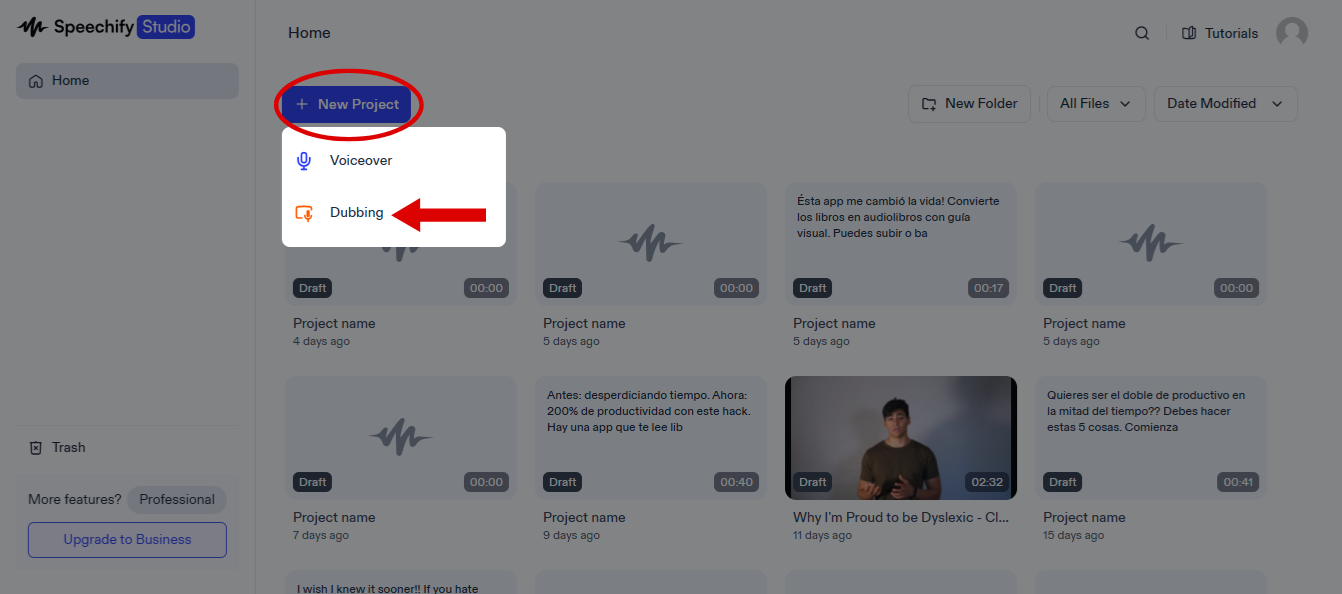
Upload your video: Upload your video file to Speechify Studio. Indicate the number of speakers, select the original language (such as English, Swedish, Slovak, Danish, Czech, Dutch, Ukrainian, Russian, Finnish, Turkish, or Filipino), and choose whether to remove filler words or adjust pauses from the original audio. Then, click “Submit."
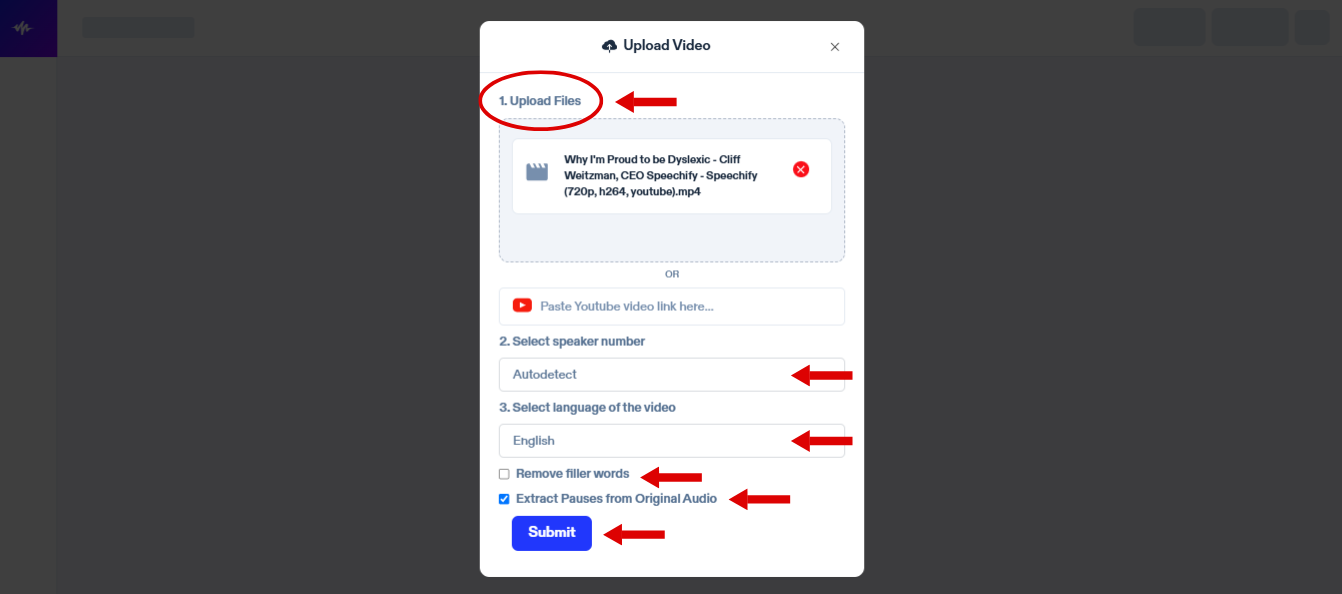
Transcribe the audio: Speechify Studio will automatically transcribe your video’s audio into text. You can review and edit the transcription subtitles if needed.
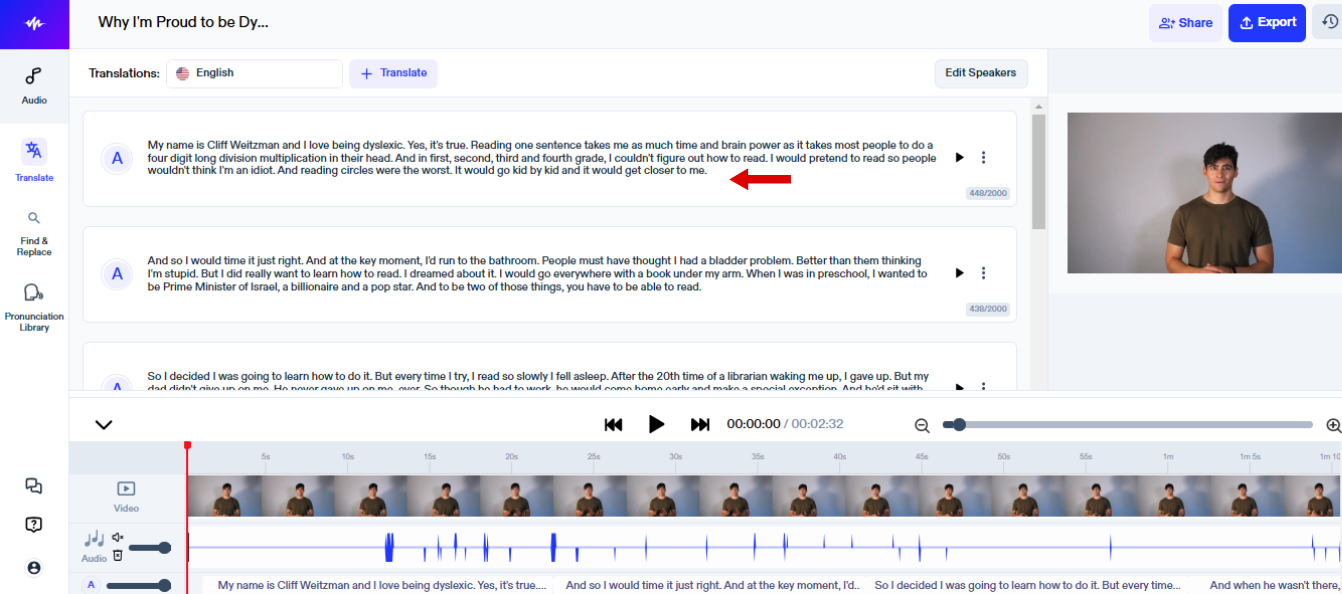
Choose Portuguese (Brazil) as the Target Language: Go to “Translate” and select Portuguese (Brazil) in the “To” field.
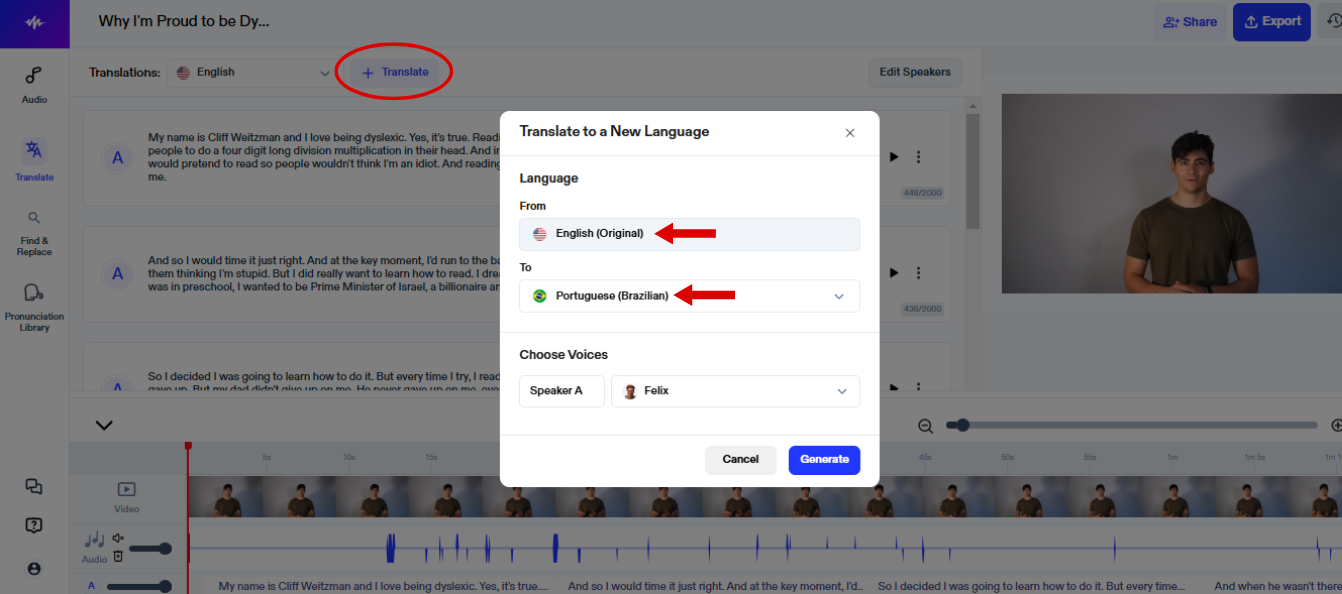
Select a Portuguese voice: Assign a natural-sounding Portuguese AI voice to each speaker in your video from the available voice options.
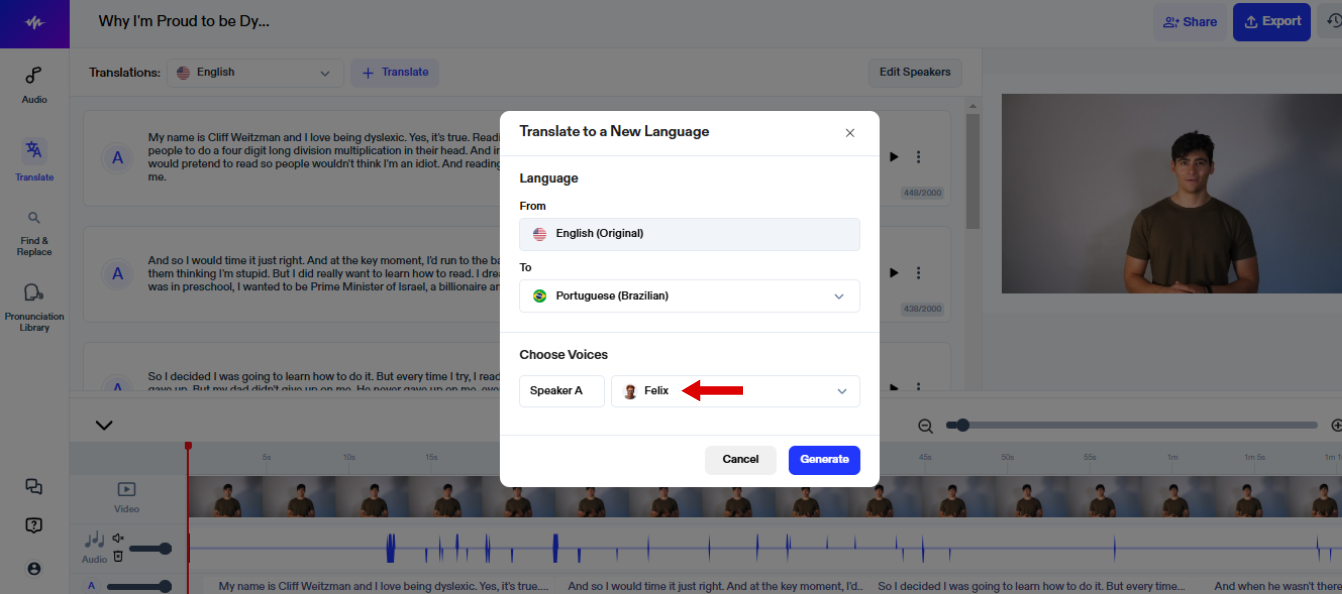
Generate the dubbed video: Click “Generate” and Speechify Studio will automatically translate the audio files and synchronize the Portuguese dub to align with the original lip movements.
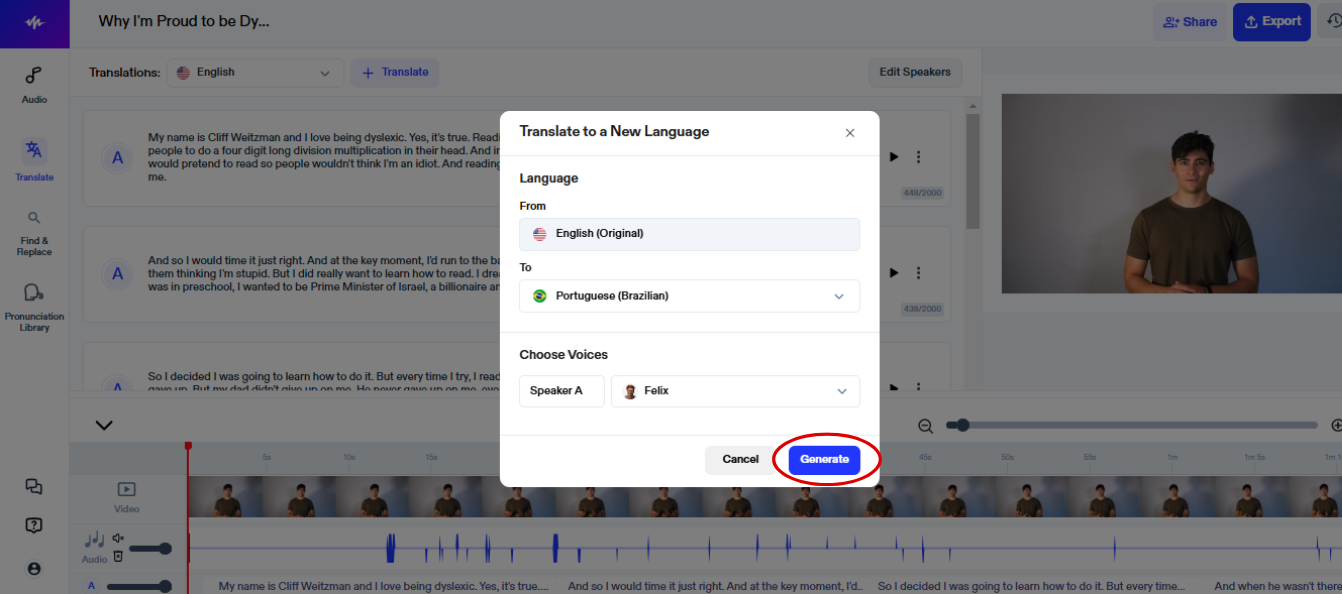
Export the final video: When the dubbing process is complete, select “Export” to download your video translation with the new Portuguese voice over and AI translation in your preferred format.
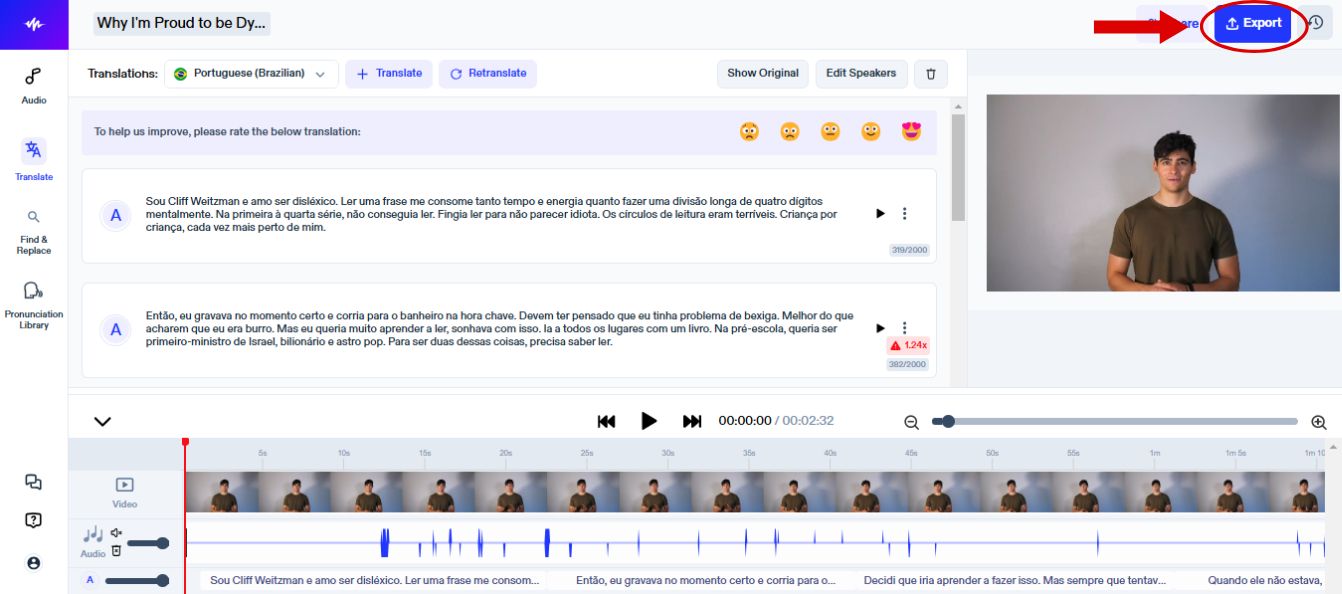
Speechify Studio’s Brazilian Portuguese AI Voice Generator
Speechify Studio’s Portuguese AI voice generator stands out as a user-friendly AI dubbing solution, crafted to meet the cultural and linguistic nuances of Brazilian Portuguese, delivering an authentic, high-quality, and detailed experience. Key features include:
- Diverse selection of realistic AI voices: Offering over 200 lifelike voices across different languages and accents—including Brazilian Portuguese, French, German, Spanish, Korean, Russian, Italian, Polish, Tamil, Chinese, Japanese, Arabic, Greek, Hindi, Hungarian, Norwegian, Vietnamese, Mandarin, Croatian, Bulgarian, Bengali, Romanian, Malay, Indonesian, and more—Speechify Studio ensures some of the most natural AI voices available, allowing users to match regional preferences.
- Range of Portuguese accents and dialects: The platform provides a variety of Portuguese accents, such as Brazilian and European, enabling a tailored experience for different Portuguese-speaking audiences.
- Advanced AI voice cloning: Speechify Studio’s Voice Over Studio allows users to clone their own voices, keeping their personal tone and style consistent across content, ideal for personal branding or recurring speakers.
- Detailed pronunciation control: Users can fine-tune pronunciation line-by-line, ensuring that specific Brazilian Portuguese sounds or expressions are accurately represented, enhancing authenticity.
- Voice customization features: Through Speechify Studio’s Voice Over feature, users can adjust pitch, tone, and emotion for expressive voices; these options will soon extend to the Dubbing interface.
- Accurate pronunciation of unique Portuguese sounds: The platform manages Brazilian Portuguese phonetics expertly, handling nuances such as nasal vowels and specific intonations, like regional variations in the pronunciation of "r" and "s" sounds, ensuring accurate and consistent pronunciation.
- Contextual adaptation in Portuguese translation: Speechify Studio adapts translations to Brazilian Portuguese context, distinguishing between formal and informal expressions. For example, it uses “tudo bem” in casual settings, while opting for formal greetings in professional contexts, capturing cultural and contextual nuances.
- Emotion detection and matching: The AI detects the emotional tone of the original audio, such as excitement, sadness, or sarcasm, and aligns the dubbing to match the intended sentiment.
- Precise lip-syncing: The platform provides accurate lip-syncing, ensuring that dubbed Brazilian Portuguese content aligns well with mouth movements, even for longer phrases.
- Multi-speaker support: Speechify Studio easily handles dubbing for multiple speakers, distinguishing between voices and adjusting language nuances to deliver clear, accurate dialogue for multi-character scenes.
- Flexible text to speech API for integration: With a robust API, Speechify Studio allows businesses and developers to seamlessly integrate Brazilian Portuguese AI dubbing and voice generation capabilities into their own platforms.
Speechify Studio’s AI Voice Generator Understands Portuguese
Speechify Studio goes beyond basic translation by offering dubbing that captures the distinct characteristics of both Brazilian and European Portuguese. This ensures that your Portuguese AI voice overs sound natural and resonate deeply with your audience, whether in Brazil, Portugal, or other Portuguese-speaking regions. Here’s how Speechify Studio captures the linguistic and cultural nuances within Portuguese for top-quality, localized dubs:
Pronunciation
Speechify Studio adapts to the specific pronunciation patterns in both Brazilian and European Portuguese, maintaining authenticity for each region:
- Brazilian Portuguese: Known for its open, melodic intonation, Brazilian Portuguese often emphasizes vowels. Regional accents, like the distinct “r” sounds in São Paulo and the “sh” sound for “s” at the end of words in Rio de Janeiro, are also captured. Speechify Studio recognizes these differences, creating a Portuguese voice over that feels familiar to Brazilian audiences.
- European Portuguese: European Portuguese has a more closed and formal tone, with pronounced consonants and less vocalized vowels. Speechify Studio respects these subtleties, giving the Portuguese from Lisbon and other regions its characteristic clarity and articulation, ensuring an authentic listening experience.
Vocabulary Differences
Speechify Studio includes regional vocabulary variations within Portuguese to ensure that each dub reflects the local context:
- Bus: In Brazil, it’s commonly “ônibus,” while in Portugal, it’s often “autocarro.” Speechify Studio adjusts based on the target audience to maintain relevance.
- Cellphone: “Celular” is typical in Brazil, while “telemóvel” is standard in Portugal. Speechify Studio uses the correct term for each region to avoid misunderstandings.
- Shoes: While “tênis” is the word for “sneakers” in Brazil, in Portugal, the term “sapatilhas” is often used. Speechify Studio applies these differences naturally within the content.
Grammatical Differences
Speechify Studio understands and incorporates grammatical nuances that differentiate European and Brazilian Portuguese:
- Pronouns: In Brazil, “você” is widely used for “you” in informal contexts, while Portugal more commonly uses “tu” in casual settings. Speechify Studio aligns with these preferences to create a natural flow.
- Verb conjugations: Brazilian Portuguese frequently uses the gerund form, as in “estou fazendo” (I am doing), whereas European Portuguese may lean towards the infinitive, like “estou a fazer.” Speechify Studio adjusts to these conjugational preferences based on the target audience.
- Possessives: In European Portuguese, possessives like “teu/tua” are often used, while in Brazil, “seu/sua” is more common. Speechify Studio ensures this distinction for accuracy and naturalness in each regional dub.
Cultural Sensitivity
Speechify Studio’s AI respects cultural sensitivities unique to each region, understanding context-specific phrases and references that vary across Portuguese-speaking areas:
- Casual greetings: In Brazil, casual greetings such as “Oi” and “Tudo bem?” are widely used, whereas in Portugal, greetings like “Olá” and “Tudo bom?” might be more common. Speechify Studio reflects these preferences for a more approachable tone.
- Unique expressions: In Portugal, terms like “fixe” are used to mean “cool,” while in Brazil, “legal” is the preferred term. Speechify Studio adopts the correct expression based on the region for relatable, authentic voice overs.
- Cultural terms: European Portuguese speakers might refer to small neighborhood markets as “mercearias,” whereas in Brazil, “mercadinhos” or “mercados” are common. Speechify Studio adapts these terms to better connect with local audiences.
By applying these region-specific nuances, Speechify Studio ensures your content feels native to both Brazilian and European Portuguese-speaking audiences, enhancing its relatability and cultural relevance.
Benefits of Brazilian Portuguese Dubbing
With over 260 million Portuguese speakers globally, Brazilian Portuguese dubbing opens doors to a vast and culturally rich audience, especially in Brazil, the largest Portuguese-speaking country. Here are some benefits of using Brazilian Portuguese AI voices for dubbing:
- Accurate localization: Brazilian Portuguese has unique vocabulary, pronunciation, and expressions that distinguish it from European Portuguese. AI dubbing tools can localize content specifically for Brazilian audiences, adapting for regional accents like the “carioca” accent in Rio or the “paulista” accent in São Paulo. This customization ensures the dubbing feels authentic, resonating with audiences in diverse parts of Brazil.
- Enhanced engagement: Localizing content in Brazilian Portuguese helps build a deeper connection with Brazilian audiences, significantly boosting viewer engagement and retention. This is especially relevant in Brazil, where viewers respond positively to content that reflects their unique cultural expressions and language nuances.
- Cost-effectiveness: Traditional dubbing can be expensive, particularly for adapting content with Brazil’s linguistic diversity. AI dubbing provides a budget-friendly alternative, making professional-quality dubbing accessible for content creators and businesses of various sizes.
- Scalability: AI-powered dubbing solutions offer easy scalability, allowing you to quickly localize individual videos or entire libraries into Brazilian Portuguese. This flexibility enables creators to efficiently adapt numerous videos, saving time and reducing production costs while expanding into new markets.
- Consistency in Branding: Brazilian Portuguese AI dubbing ensures a uniform tone, style, and pronunciation, which is crucial for brands striving for a cohesive voice across different regions. Consistency is especially important in Brazil, where linguistic harmony can enhance authenticity and strengthen brand trust among local audiences.
AI Dubbing: Text to Speech Portuguese AI Voices vs. Voice Cloning
AI dubbing enables you to tailor content for diverse Portuguese-speaking audiences, spanning from Portugal to Brazil and regions across Africa, ensuring each localized video truly connects with your target viewers. Best of all, you have two options to choose from: text to speech AI voices or voice cloning. Let’s dive into each:
Portuguese Text to Speech Voices
Text to speech (TTS) technology is one of the quickest ways to create AI-generated voice overs in Brazilian Portuguese. It involves converting written text into spoken language using pre-generated voices. These voices can be fine-tuned to match the intonations of Brazilian Portuguese.
For example, when using a TTS engine for a YouTube video aimed at a Brazilian audience, the system would not only convert the text to Portuguese, but it would also inflect words like "obrigado" or "tchau" correctly depending on the context. Additionally, TTS can handle rapid translation and vocalization, which is perfect for social media content and podcasts where turnaround time is critical.
Portuguese Voice Cloning
Voice cloning goes one step further by allowing you to replicate a specific person’s voice in Brazilian Portuguese. This technology allows brands and influencers to maintain a consistent voice across multiple projects. For example, if a Brazilian influencer, such as Bianca Andrade, regularly produces content in Portuguese but wants to expand into the English market, voice cloning can help them "speak" English with their own voice while maintaining the Portuguese versions using AI-generated voice overs.
Voice cloning can even reproduce a distinct accent from Brazil, such as a Paulistano accent (from São Paulo), where the "r" sound is pronounced slightly differently compared to other regions of Brazil. For creators and companies who need both brand consistency and regional authenticity, voice cloning is a game-changer.
Speechify Studio Use Cases for Brazilian Portuguese AI Dubbing
Dubbing with Brazilian Portuguese AI voices provides diverse opportunities for creators, businesses, and media companies to engage effectively with Portuguese-speaking audiences. Here are several key use cases where utilizing AI voices for Portuguese dubbing on Speechify Studio can be especially beneficial and help overcome language barriers:
AI Voices for Brazilian Portuguese Podcasts
Podcasting has surged in popularity in Brazil, with creators like Mamilos Podcast and Café da Manhã leading the way in producing engaging, thought-provoking content. Brazilian podcasters can use Speechify Studio’s AI voices to dub guest interviews or entire episodes into multiple languages. For example, if Mamilos Podcast—which often discusses social issues—wanted to reach Spanish or English speakers, they could dub their episodes using Speechify Studio’s AI voice cloning to maintain their conversational tone in a natural-sounding Portuguese (Brazil), Spanish, or English version.
AI Voices for Portuguese Social Media
Brazil is a social media powerhouse, with influencers and brands constantly creating dynamic, fast-paced content. Influencers like Camila Coelho or Felipe Neto can use Speechify’s AI voices to dub their content into multiple languages, including Portuguese, English, and French. For instance, when launching a new beauty line, Camila Coelho could release tutorial videos in Brazilian Portuguese for her local audience, while also offering English or French dubs to expand her reach internationally.
AI Voices for Portuguese Multilingual Marketing Campaigns
Multinational companies operating in Brazil often run marketing campaigns in multiple languages. AI voice overs allow businesses like Natura (a Brazilian cosmetics company) or Ambev (a major beverage corporation) to create multilingual versions of their ads quickly and cost-effectively. Nike and Adidas already dub their ads and marketing materials into Brazilian Portuguese to strengthen their connection with local audiences and with Speechify Studio, companies can dub their Portuguese ads into languages like Spanish, English, and even niche markets such as Korean or Turkish, ensuring their message reaches a global audience.
AI Voices for Portuguese Audiobooks
Audiobooks are on the rise in Brazil, with more people opting to listen to books on-the-go. Popular platforms like Ubook and Storytel Brasil are capitalizing on this trend by offering a variety of audiobooks in Brazilian Portuguese. Authors and publishers can use Speechify Studio to dub their English-language audiobooks into Portuguese to reach a larger audience. Brazilian authors can also use AI voice overs to expand their reach. Imagine Paulo Coelho, the famous Brazilian author of The Alchemist, dubbing his works into English, Spanish, or Chinese through AI, ensuring his literature reaches even more readers globally. Publishers like Companhia das Letras have already embraced dubbing to make their content available to more listeners.
AI Voices for Portuguese Entertainment
Entertainment is a key industry in Brazil, with dubbed content being the norm across TV shows, movies, and streaming platforms. AI dubbing tools allow Brazilian filmmakers and content creators to create localized versions of their media for Brazilian audiences, while also producing dubs for international markets. For example, Rede Globo, Brazil’s largest television network, could use Speechify Studio to dub its popular telenovelas like Avenida Brasil into multiple languages, including Spanish, French, and English, for a global audience.
AI Voices for Portuguese Educational Content
Brazilian educational content providers like Descomplica or Me Salva! frequently produce digital courses and tutorials. AI voice overs make it easy for these platforms to create high-quality, natural-sounding Portuguese versions of their courses, while also expanding into other languages. For example, a coding tutorial initially created in English can be dubbed into Brazilian Portuguese using Speechify Studio, making it accessible to Brazilian students who prefer learning in their native language. Another example would be for companies like Descomplica and Me Salva! which provide educational resources in Brazilian Portuguese to dub content into other languages like English or Spanish.
AI Voices for Brazilian Portuguese Video Games
Brazil is one of the largest video game markets in the world, with millions of active gamers. The Brazilian gaming community is so massive that game developers already recognize the importance of localizing their content into Brazilian Portuguese. Companies like Ubisoft and Rockstar Games regularly dub their major titles into Portuguese. For example, the Assassin’s Creed and GTA franchises are fully dubbed in Brazilian Portuguese, ensuring an immersive experience for local players. With Speechify Studio, game developers can quickly and affordably dub in-game dialogue and instructions into Brazilian Portuguese, making their games more accessible to Brazilian players.
AI Voices for Portuguese Accessibility
Accessibility is a growing concern for content creators, especially as media becomes more inclusive. AI voice overs can help provide dubbed versions of content for visually impaired audiences in Brazil. Platforms like Globoplay and Netflix Brasil can use Speechify Studio to generate Brazilian Portuguese audio descriptions, ensuring that visually impaired users can still enjoy their favorite shows and movies.
Speechify Studio Competitors with Portuguese AI Voices
While Speechify Studio remains a top Portuguese AI dubbing platform, it’s not the only AI voice generator on the market. Here’s a look at how it compares to other platforms offering Portuguese AI voices:
Speechify Studio
With support for over 150 languages and accents, and both Brazilian and European Portuguese AI voice options, Speechify Studio shines as a comprehensive, user-friendly dubbing and video editing solution. Its features capture the emotion, timing, tone, and unique qualities of the original speaker. Additional tools include multi-speaker support, auto-subtitling, access to stock music and video footage, voice cloning, and realistic text to speech AI voices, making it ideal for users seeking versatile and robust dubbing solutions.
ElevenLabs
Supporting 29 languages, ElevenLabs offers an intuitive editing interface that retains the original speaker's emotional tone and timing. With capabilities for multi-speaker dubbing, voice cloning, and text to speech, ElevenLabs provides natural-sounding AI voices for diverse media projects.
Rask
Rask is tailored for cinematic projects, supporting 135 languages and offering advanced voice cloning, multi-speaker support, and seamless lip-syncing—ideal for filmmakers prioritizing smooth voice integration.
Murf
With support for 20+ languages, Murf specializes in preserving the original speaker’s tone, emotion, and style. Murf’s voice cloning and text to speech AI voices make it a solid choice for projects that require expressive, nuanced voice overs, appealing to professional audio production needs.
DupDub
Supporting 70+ languages and accents, DupDub offers features like auto-subtitles, multi-speaker support, and lip-syncing capabilities. It retains the original speaker’s style, making it a dependable option for nuanced voice cloning and text to speech needs.
Dubverse
Dubverse supports 60+ languages, including features such as auto-subtitling, contextual translations, and lip-syncing. Its multi-pronunciation and tonal variation capabilities provide flexible voice cloning and text to speech options tailored to diverse linguistic needs.
Wavel
Wavel’s catalog of 70+ languages offers up to 95% accuracy in preserving the speaker’s original tone, style, and timing. Its multi-speaker support, synchronization tools, and advanced AI voice cloning make it well-suited for high-precision projects.
InVideo
With 50+ languages and accents, InVideo is ideal for team projects, supporting multiplayer editing and offering access to a library of over 16 million stock media files. Its voice cloning and text to speech capabilities are perfect for collaborative projects requiring extensive media resources.
Conclusion
Portuguese AI dubbing opens numerous possibilities for content creators aiming to reach Portuguese-speaking audiences. Whether producing podcasts, YouTube videos, or educational content, AI dubbing tools like Speechify Studio enable the creation of high-quality, natural-sounding Portuguese voice overs. With features like voice cloning and real-time dubbing, these tools expand accessibility without the high costs of traditional dubbing. Embrace AI to elevate your Portuguese video content and multilingual campaigns.
FAQ
How can I translate and dub a video with AI in Portuguese?
You can translate and dub your video in Portuguese effortlessly with Speechify Studio's AI voice technology, providing seamless multilingual support.
How can I dub voice in video in Portuguese?
Use Speechify Studio to quickly dub your video in Portuguese, offering realistic, high-quality AI-generated voices.
What is the best AI video dubber?
Speechify Studio stands out as the best AI video dubber with its lifelike AI voices, and advanced voice cloning and language support.
What is the Portuguese voice over app?
For a top Portuguese voice over app, try Speechify Studio, which offers precise, natural-sounding AI voices.
How do I translate a video from English to Portuguese?
Easily translate and convert your English video to Portuguese with Speechify Studio’s translation and dubbing features.
How can I sub a video in Portuguese for free?
With Speechify Studio you can dub a video in Portuguese using the free plan without subscribing to premium pricing or needing a credit card.





